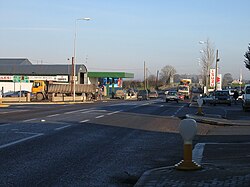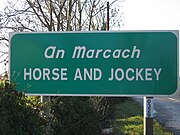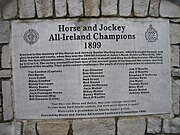Horse and Jockey
| Horse and Jockey Irish: An Marcach | |
| County Tipperary | |
|---|---|
 Road junction at Horse and Jockey | |
| Location | |
| Grid reference: | S157517 |
| Location: | 52°36’59"N, 7°46’5"W |
| Data | |
| Local Government | |
Horse and Jockey is a village in County Tipperary. It stands by the R639 road, where it meets the N62 to Thurles and just off junction 6 of the M8 motorway, which by-passed the village in December 2008. Horse and Jockey is in the parish of Moycarkey in the Barony of Eliogarty.
Name

The origin of the name 'Horse and Jockey' is unclear. Bassett's 1889 directory of County Tipperary listed the village, noting that it had six houses.[1] The normal explanation is that the name is derived from a public house of the same name. However, although there is currently a hotel called the Horse and Jockey, in the mid-20th Century the only public house in the village, from which the current hotel was subsequently developed, was known simply as O'Keeffe's, after the family which owned it. Another tentative suggestion is that, since the village was on a mail coach route, it may have been the location of one of the Bianconi Inns established by the transport magnate, Charles Bianconi, and that the name may be somehow connected with such an establishment, if it existed. If there was such an inn, it may what is indicated by the use of italics in the rendering of the name The Horse and Jockey on this 19th-century map, part of the Ordnance Survey First Edition 6" Series; if so, the map appears to indicate that the inn was on the north-east corner of the village, instead of the south side of the village where the public house was located in mid-20th century.
The name officially enrolled for the village for use in the Irish language is An Marcach, but this is merely a translation of the modern colloquial English name, The Jockey. In the mid-20th century, its official name in Irish was Baile na Páirce, the Irish for the townland of Parkstown, Ballymoreen on which the northern part of the village is built, butthis again is an artificial Gaelic derivation from an English name.
History

19th century
In November 1823, a south-bound mail coach was attacked at the village. Shots were fired but the coach managed to get past an obstruction of boulders and carts which had been across the road. However, the coach then capsized. When locals, attracted by the noise, came to the scene the attackers fled and the coach was righted. However, when it reached Clonmel, it was noticed that one passenger was missing. This was the Hon Mr Browne, brother of Lord Kenmare. Later, it was learned that he had taken refuge in a house near the site of the attack and arrived in Cork the next day, uninjured.[2]
In 1827, as a result of land agitation, a man from nearby Ballytarsna committed a murder at nearby Rathcannon. His subsequent execution led, in revenge, to a second murder (as well as several attempted and threatened murders) and this, in turn, led to the execution or transportation for life of a dozen men.
Twentieth century
The Horse and Jockey Senior Hurling team, representing County Tipperary, won the 1899 All-Ireland championship at Jones's Road (now Croke Park) in Dublin, beating the team from Blackwater which represented County Wexford.[3] For some reason, the '1899' match was actually played in 1901, on 24 March that year.
On 17 February 1980, the Derrynaflan hoard was discovered about two miles east of Horse and Jockey, on an island of dry land in Liskeveen bog which was known locally as "the Gobán Saor's island". The hoard of 8th- or 9th-century religious objects is believed to have been secreted during the Viking raids of the 10th and 11th centuries, including the famed Derrynaflan Chalice.
Transport history
In the early 19th century, the village was on the route of a mail coach. In November 1823, it was the site of an attack on a south-bound coach.[4]
Horse and Jockey railway station,[5] on the line between Thurles and Clonmel, opened on 1 July 1880, closed for passenger traffic on 9 September 1963.
After the Thurles-Clonmel railway closed, the railway bridge at Horse and Jockey was demolished. Until its demolition, it had been a prominent landmark on the main road between Cork and Dublin, because its steepness and narrowness forced traffic to slow down considerably.
Sport
- Hurling: Part of the Moycarkey Borris GAA Club.
- Handball: A handball alley on the road leading eastward from the village
- Dog racing: In the mid-1960s, there was a small dog-racing track in the village, just behind O'Keeffe's public house, a site is now occupied by part of the Horse and Jockey Hotel complex. Racing was not restricted to greyhounds. The "hare" was pulled by a man in small hut at the eastern end of the track, just beside the ball alley.
Pictures
-
One year before Two-Mile
-
N62 Junction at Horse and Jockey
-
Horse and Jockey pub
References
- ↑ George Henry Bassett, The Book of County Tipperary, 1889, reprinted in 1991 as County Tipperary 100 years ago: a guide and directory, 1889, page 394
- ↑ Horse & Jockey Thurles Remembers The Past
- ↑ Mike Cronin, William Murphy, Paul Rouse, editors, The Gaelic Athletic Association, 1884-2009, Irish Academic Press, 2009, page 283
- ↑ Horse & Jockey Thurles Remembers The Past
- ↑ Horse & Jockey Thurles Remembers The Past, contains a photograph of a steam train at Horse and Jockey railway station


